
Suspension training is gaining in popularity. The TRX can be used to achieve a range of objectives: it can be easily used at home or in training centers and it allows us to perform a wide variety of exercises.
This type of training uses body weight and gravity to provide resistance and create different levels of difficulty. It also requires a great deal of stability work involving the abdominals. Here are some details on its many features as well as specific progressive exercises according to your level.
How does the TRX work?
The TRX has two handles and stirrups and two straps that you can lengthen or shorten. The longer you extend the straps, the greater the leverage and the more difficult it will be to have good control over your movement. Thus, you increase the level of difficulty.
Another way to progress in the execution, besides changing the length of the straps, is to incline yourself more in relation to the anchor. The effect of gravity increases the tension and requires more work from the muscles involved. Although the operation is quite simple, do not underestimate the level of difficulty, as some exercises are much more demanding than they appear.
Exercises you can do with the TRX
Here are several exercises to be performed with the TRX, in three (3) categories ranging from beginner to advanced exercises. To ensure proper technique and execution, don’t hesitate to ask our kinesiologists.
BEGINNER EXERCISES:
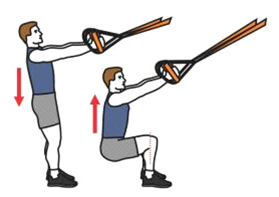
Squat:
A complete exercise that works all the lower limbs all the way to the glutes. It is a basic movement where the TRX serves as a support for balance and to have a good range of motion.
- Standing position facing your TRX
- Feet shoulder width apart
- Push your buttocks back and down until you reach a 90-degree angle at the knees or forward depending on your ability
- Keep your back straight, your head in line with your body and your abdominals contracted
- Push through the heels, squeeze the glutes, and push up to come back up.
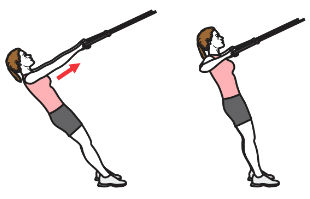
High elbow row:
To work the large muscles of the back, posterior deltoids and biceps, this exercise is complete in addition to involving your abdominals. It’s pretty beginner-friendly, as the movement is simple, but the more you lean in, the more the difficulty level climbs and there are a multitude of possible variations.
- Stand facing your TRX, let the TRX support you.
- Pull your body in, elbows out and palms down.
- Keep your head in line with your body and contract your abdominal muscles.
- Return to the starting position while controlling the extension of your arms.
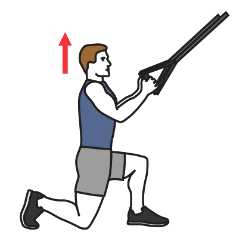
Supported split squat:
A second exercise for the lower limbs, a little more complex which demands more from the quadriceps and glutes. In this case, the TRX also allows you to maintain your balance to have an optimal technique and amplitude.
- Stand in front of your TRX.
- Take a good step backwards: your front foot remains completely on the ground and your back foot will be resting on the forefoot.
- Bend your back knee towards the ground until you reach 90 degrees on your back leg or less depending on your ability.
- Push through your front heel and back forefoot to get back to the starting position.
- Keep your head in line, abs contracted and shoulders down
- Raise your arms to form a Y shape to elevate your body
- Avoid arching your back
- Return to the starting position while controlling your movement
Intermediate exercises
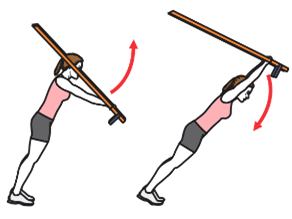
Superman:
It is an exercise a little more complex because of the instability and the effort at shoulder level and its intense work at abdominal level.
- Keeping your feet planted, stand holding both TRX handles out in front, perpendicular to your body.
- Lean forward at desired incline.
- With control of the movement, raise your arms so that your hands are extended above your head.
- Pause for a moment and then return to that starting position.
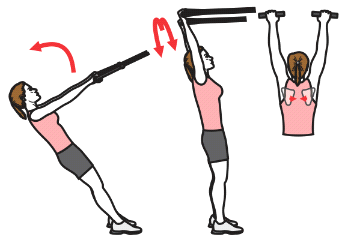
Y-fly:
The arm movement for this exercise is more complex and requires more arm, ab, and back muscle work. With the arms further away from the body, it makes the movement even more complex.
- Stand upright facing the TRX anchor, keeping feet shoulder width apart, and holding onto the TRX handles with your arms extended.
- Bring your feet in closer to the anchor point, so you are now leaning back at around 30-45 degrees.
- From this leaned back, straight-bodied position, engage your shoulders and proceed to pull the TRX handles up over your head, forming a Y with your body. Lead the movement with your hips and keep your arms straight.
- Lower yourself back down to the starting position.
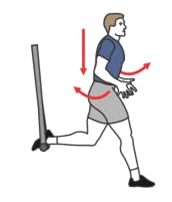
Elevated split squat:
Following the “Supported Split Squat” mentioned above, this exercise, which still works mainly the glutes and quadriceps, is more complex, because the foot in the strap brings a considerable amount of instability to all phases of the movement. It is important to maintain good technique and keep the front knee in line.
- Standing on one leg, facing away from the TRX anchor, place other foot in stirrups; toes and hips are facing forward.
- Begin the movement by bending the supporting leg as you lunge back, bring the TRX supported knee back and towards the floor, until you feel a stretch in the hip flexors. Hands can rest on hips for support, or they can mimic a running motion with the split squat.
- Push back up with the supporting leg and drive the TRX knee forward past the supporting leg.
ADVANCED EXERCISES:
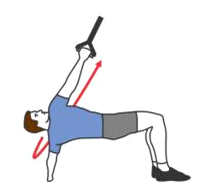
One arm row with reach:
This exercise is very complex because of its initial position and its rotational movement at the trunk level. It involves mainly the back, shoulder, and biceps muscles as well as the abdominals.
- Hold the TRX with one hand and bend over so that the straps are under tension, keep your shoulders perpendicular to the ground.
- Rotate your upper body and try to bring the hand that was on the ground as high as possible near the TRX straps.
- Contract the abdominals and keep the head in line.
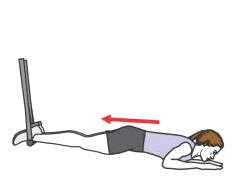
Body saw:
The starting position in the abdominal plank can be quite complex, even more so with the feet in the stirrups. The exercise is even more complex because of its high abdominal and shoulder muscle involvement.
- Place the handles so they are about 6 inches off the ground.
- Place your feet in the stirrups so that the tops of your feet are facing downwards.
- Get on your forearms and make your body into a straight line parallel to the floor.
- Keeping your body parallel to the floor push with your forearms and rock your body 6-8 inches slowly back and forth.
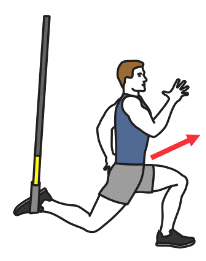
Sprinters lunge:
Always with the objective of working the lower limbs, mainly the glutes and the quadriceps, this exercise is the continuation of the “Elevated Split Squat”. Indeed, its explosive movement of bringing the back knee forward by performing a jump, requires a greater effort at the time of the muscular contraction and a great stability at the level of the front leg joints.
- Put your back foot into the TRX and slightly move your front foot forward.
- Keep your back straight and your abdominals contracted.
- While maintaining tension in the back leg, move the back leg back and bend the front knee until you reach a 90-degree angle or less depending on your ability.
- Keep the front knee above the ankle.
- Push up in your heel while bringing your back leg toward your buttocks in an explosive motion. The movement can include a jump if that is possible for you.
*Images and descriptions are sourced from or inspired by the Hexfit software that our trainers use with their clients.
As you can see, the TRX allows for a variety of movements that I have only begun to detail here. This versatile tool adds variety to your current routine while maintaining good results. On the other hand, it is important to mention that TRX can ALSO be a good tool for your stretches. Not sure how to proceed or how to use this tool yet? Ask a trainer/kinesiologist for help during your next visit to the gym and they will gladly assist you!
The TRX, a unique technique! is a post from Nautilus Plus. The Nautilus Plus blog aims to help people in their journey to fitness through articles on training, nutrition, motivation, exercise and healthy recipes.
Copyright © Nautilus Plus 2023
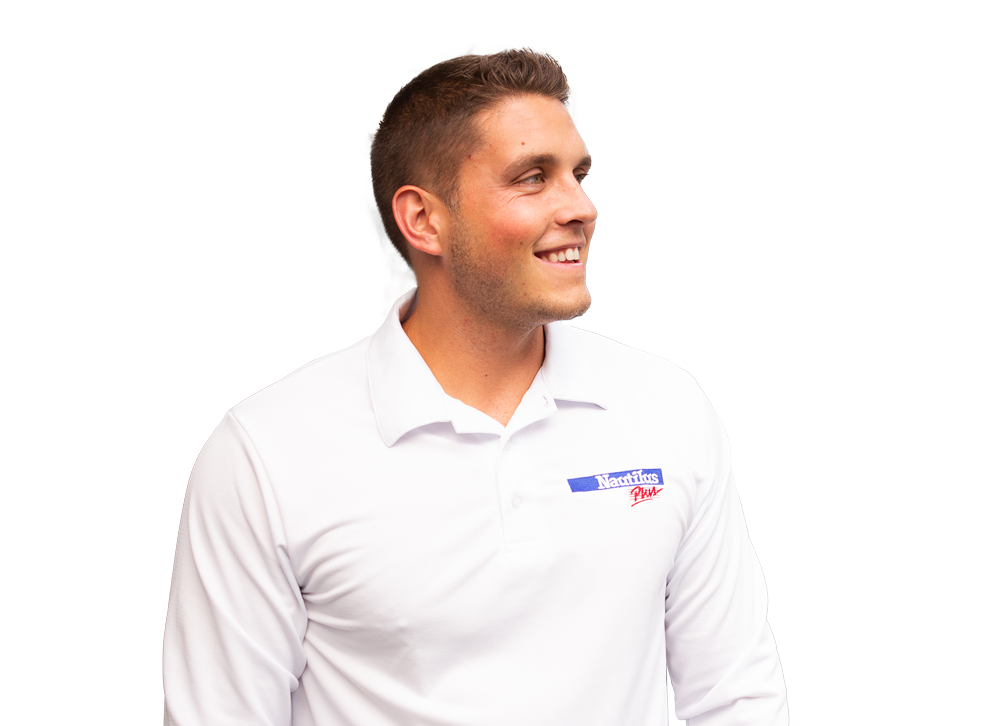
A session with a personal trainer will help you to progress!

Let's determine your fitness goals together and get some expert advice!
Make an appointment with a personal trainer

